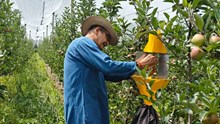
Small cardamom, scientifically known as Elettaria cardamomum, is a prized spice used globally in culinary and medicinal applications. It is often referred to as the 'Queen of Spices,' holds a significant place in the spice industry due to its unique flavor and aroma. Its cultivation faces challenges like pest infestations and diseases such as Katte virus and rhizome rot.
The ICAR-Indian Institute of Spices Research (IISR) has developed several high-yielding varieties of small cardamom to enhance productivity and resistance to diseases. This article delves into four prominent varieties: IISR Vijetha-1, IISR Avinash (RR1), Kodagu Cardamom-Suvasini (CCS-1), and Appangala-2.
1. IISR Vijetha-1
IISR Vijetha-1 is a Malabar-type variety specifically developed for mosaic disease-infested areas with moderate to heavy shade. It boasts strong resistance to Katte disease, ensuring consistent productivity even under adverse conditions.
-
Yield: 643 kg dry capsules/ha (potential yield: 979 kg dry capsules/ha).
-
Quality: Essential oil content of 7.9%, with 77% bold capsules (7.2 mm).
-
Morphology: Green aerial shoots, plant height of 172 cm, and 36 tillers per clump.
-
Pest Resistance: Field tolerance to thrips and shoot/panicle/capsule borers.
2. IISR Avinash (RR1)
Derived from the progeny of CCS-1, this variety is ideal for rhizome rot-infested areas, such as valleys. It is widely appreciated for its high productivity and extended flowering period.
-
Yield: 847 kg dry capsules/ha (potential yield: 1483 kg dry capsules/ha).
-
Quality: Essential oil content of 6.7%, with extended flowering periods.
-
Morphology: Dark green aerial shoots, plant height of 228.6 cm, and 46 tillers per clump.
-
Disease Resistance: Resistant to rhizome rot caused by Pythium vexans and Rhizoctonia solani.
3. Kodagu Cardamom-Suvasini (CCS-1)
Released in 1997, CCS-1 is a Malabar-type variety adapted to all cardamom-growing tracts of Karnataka. It responds well to high production technology and nutritional inputs. Highlights include:
-
Yield: 745 kg dry capsules/ha (potential yield: 1322 kg dry capsules/ha).
-
Quality: Essential oil content of 8.7%, with 89% bold capsules (7.2 mm and above).
-
Morphology: Green aerial shoots, plant height of 205 cm, and 41 tillers per clump.
-
Pest Resistance: Tolerant to thrips and shoot/panicle/capsule borers.
4. Appangala-2
A hybrid variety released in 2014, Appangala-2 is a cross between Appangala-1 and NKE-19. It is recommended for Katte virus-infected areas. Key characteristics include:
-
Yield: 927 kg dry capsules/ha (potential yield: 1393 kg dry capsules/ha).
-
Quality: Essential oil content of 6.3%, with high α-terpinyl acetate (40.32%).
-
Morphology: Dark green aerial shoots, plant height of 215.94 cm, and 31 tillers per clump.
-
Disease Resistance: Mosaic virus resistance under field conditions.
Side-by-Side Comparison
|
Variety |
Yield (kg/ha) |
Quality |
Morphology |
Disease/Pest Resistance |
|
IISR Vijetha-1 |
643 (potential: 979) |
Essential oil: 7.9%, 77% bold capsules (7.2 mm) |
Green aerial shoots, height: 172 cm, 36 tillers/clump |
Resistant to Katte disease; tolerance to thrips and shoot/panicle/capsule borers |
|
IISR Avinash (RR1) |
847 (potential: 1483) |
Essential oil: 6.7%, extended flowering period |
Dark green aerial shoots, height: 228.6 cm, 46 tillers/clump |
Resistant to rhizome rot (Pythium vexans, Rhizoctonia solani) |
|
Kodagu Cardamom-Suvasini (CCS-1) |
745 (potential: 1322) |
Essential oil: 8.7%, 89% bold capsules (7.2 mm and above) |
Green aerial shoots, height: 205 cm, 41 tillers/clump |
Tolerance to thrips and shoot/panicle/capsule borers |
|
Appangala-2 |
927 (potential: 1393) |
Essential oil: 6.3%, high α-terpinyl acetate (40.32%) |
Dark green aerial shoots, height: 215.94 cm, 31 tillers/clump |
Resistant to mosaic virus under field conditions |
These cardamom varieties are not only tailored to thrive in specific ecological and disease-prone zones but also offer unique qualities like disease resistance, adaptability to diverse growing conditions, and yield potential that make them significant for boosting productivity and addressing agricultural challenges.
These high-yielding varieties have revolutionized small cardamom farming, providing By adopting these improved varieties, the spice industry can elevate productivity, meet market demands, and maintain quality standards.
















